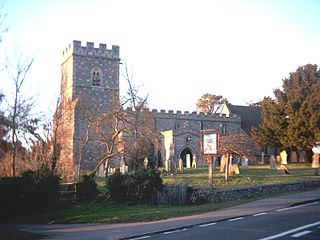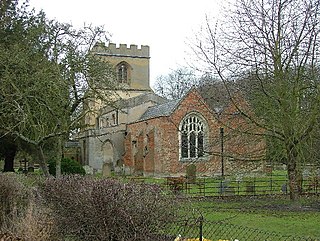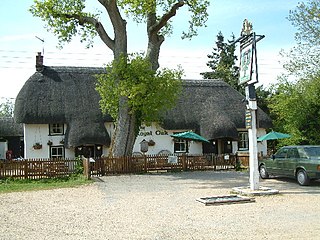Overview
The village of Whitsbury consists of a straggling village street running roughly north/south with timbered and thatched houses. [3] The parish was originally in Wiltshire, but was transferred to Hampshire in 1895. [3] There are several tumuli on Whitsbury Down and an Iron Age hillfort, known as Whitsbury Castle, overlooks the village. [4] The land rises generally from south to north, reaching a height of 120 metres at Whitsbury Castle Ditches, and Iron Age hill fort. Whitsbury Wood and Whitsbury Common are to the east and south of the village respectively. [3] The only inn in the village is the Cartwheel Inn. [5] There used to be a shop, a small post office, and a village school, located just to the south of Major's Farm. The school was demolished during the 1950s and there is no sign of it now. [5] The main employment is based upon the very successful equine and agricultural industry, comprising 4 major yards of racing stables, stud. [6] Consequently, the people-intense nature of these businesses has allowed Whitsbury to retain a charm that has been lost in many other villages and communities. [6] William Hill, of betting shop fame, owned a stud farm in Whitsbury, [7] and is buried in Whitsbury. The Gold Cup winner Desert Orchid was trained in Whitsbury. [8]
History
Whitsbury is not listed in the Domesday Book of 1086 – but it has occasionally been identified with the Witeberge listed in the Wiltshire folios, but Witeberge is usually identified with Woodborough. [3] [9] [10] The name Whitsbury, recorded as Wiccheberia in the 12th century, may mean "fort of the wych elm." [11] The fort ("burh") is presumably the hillfort. [11]
Whitsbury was said in 1274–5 to have belonged to the Kings of England until the time of Henry I, who then granted it to Reading Abbey. [3] Another slightly later source states that Henry I had given the manor to Godfrey de Vilur, and it was he who transferred it to the abbey. [3] The ==manor certainly belonged to the abbey in the time of Henry I, who confirmed to it the church and land in Whitsbury which had belonged to Ingram the monk, and later kings added similar confirmations. [3] In 1222 the Abbot of Reading obtained a grant of twenty oaks in the New Forest for mending his houses at Whitsbury. [3]
After the Dissolution of the Monasteries the site of the manor was leased in 1540 for twenty-one years to Anthony Cotes, the tenant of the abbot, and five years later the manor itself was granted to Richard Morrison. [3] He died in 1556, leaving a son and heir Charles, who was succeeded in 1599 by his son Sir Charles Morrison, 1st Baronet, created a baronet in 1611. [3] The latter sold the manor in 1623 to Sir John Cooper, 1st Baronet of Rockbourne, and from that date it descended with Rockbourne. [3]

Great and Little Kimble cum Marsh is a civil parish in central Buckinghamshire, England. It is located 5 miles (8 km) to the south of Aylesbury. The civil parish altogether holds the ancient ecclesiastical villages of Great Kimble, Little Kimble, Kimblewick and Marsh, and an area within Great Kimble called Smokey Row. The two separate parishes with the same name were amalgamated in 1885, but kept their separate churches, St Nicholas for Great Kimble on one part of the hillside and All Saints for Little Kimble on other side at the foot of the hill.

Fordingbridge is a town and broader civil parish with a population of 6,000 on the River Avon in the New Forest District of Hampshire, England, near the Dorset and Wiltshire borders and on the edge of the New Forest, famed for its late medieval seven-arch bridge.

Marchwood is a village and civil parish located in Hampshire, England. It lies between Totton and Hythe on the western shore of Southampton Water and directly east of the New Forest. The population of the village in the 2011 census was 6,141.

Alton is a civil parish in Wiltshire, England. The parish includes the adjacent villages of Alton Barnes and Alton Priors, and the nearby hamlet of Honeystreet on the Kennet and Avon Canal. It lies in the Vale of Pewsey about 6 miles (10 km) east of Devizes.

Hexton is a small village and civil parish in Hertfordshire, England, about 6 miles (10 km) west of Hitchin.
Wellow is a village in Nottinghamshire, England. According to the 2001 census it had a population of 444, increasing to 470 at the 2011 census.

Minstead is a small village and civil parish in the New Forest, Hampshire, about 2 miles (3.2 km) north of Lyndhurst. There is a shop and a pub, the Trusty Servant. Sir Arthur Conan Doyle's grave is under a large tree at the back of the 13th century All Saints' church.

Sway is a village and civil parish in Hampshire in the New Forest national park in England. The civil parish was formed in 1879, when lands were taken from the extensive parish of Boldre. The village has shops and pubs, and a railway station on the South West Main Line from Weymouth and Bournemouth to Southampton and London Waterloo. It is the site of Sway Tower, a 66-metre (217 ft) concrete folly built in the 19th century.

Rockbourne is a village and civil parish in the English county of Hampshire, close to Fordingbridge.

Breamore is a village and civil parish near Fordingbridge in Hampshire, England. The parish includes a notable Elizabethan country house, Breamore House, built with an E-shaped ground plan. The Church of England parish church of Saint Mary has an Anglo-Saxon rood.

Damerham is a rural village and civil parish in the New Forest district of Hampshire, England, near Fordingbridge. The area has notable Neolithic and Bronze Age barrows. It was the site of an Anglo-Saxon religious community, mentioned in the will of Alfred the Great. By the time of Domesday Book (1086), Damerham was a major settlement in the possession of Glastonbury Abbey. The village has a riverside mill and a Norman church.

Martin is a village and civil parish in the New Forest district of Hampshire, England. The nearest town, Fordingbridge, is 7 miles (11 km) to the south-east, and the cathedral city of Salisbury is 12 miles (19 km) to the north-east.

Dinton is a village, civil parish and former manor in Wiltshire, England, in the Nadder valley on the B3089 road about 8 miles (13 km) west of Salisbury. The parish population was 696 at the 2011 census, estimated at 733 in 2019. The civil parish includes the village of Baverstock, about 1 mile (1.6 km) east of Dinton village.

Burley is a village and civil parish in the New Forest, Hampshire, England. It has ancient origins and is now somewhat tourist-orientated.

Bramshaw is a small village and civil parish in Hampshire, England. It lies just inside the New Forest. The name Bramshaw means Bramble Wood.

Colbury is a small village in the New Forest National Park, in Hampshire, England. The village lies along Deerleap Lane, near the modern village of Ashurst.

Knook is a small village and civil parish in Wiltshire, England. The village lies to the north of the River Wylye at the edge of Salisbury Plain, about 4+1⁄2 miles (7 km) southeast of Warminster, close to the A36 road to Salisbury.

Netley Marsh is a village and civil parish in Hampshire, close to the town of Totton. It lies within the New Forest District, and the New Forest National Park. It is the supposed site of the battle between an invading Anglo Saxon army, under Cerdic and a British army under the probably fictitious king Natanleod in the year 508.

Whitsbury Castle, or Whitsbury Castle Ditches, is the site of an Iron Age univallate hillfort located near the village of Whitsbury in Hampshire. The fort is roughly pear-shaped, located on a chalk outcrop, and covering approximately sixteen acres. The defenses comprise two large ramparts with outer ditches and an additional counter scarp bank on the northern half. The original entrance was at the southwestern corner but has been destroyed by the construction of a post-medieval manor house. The site has been in use throughout the ages, with excavation revealing mesolithic activity, an association with a Bronze Age ranch boundary, an Iron Age hillfort settlement, followed much later by Anglo-Saxon renovation and reuse of the defences. The site is privately owned but is flanked externally on all sides but east by public bridleways.

North Gorley is a hamlet in the New Forest National Park of Hampshire, England. Its nearest town is Fordingbridge, which lies approximately 2 miles (3.2 km) north of the hamlet.
























